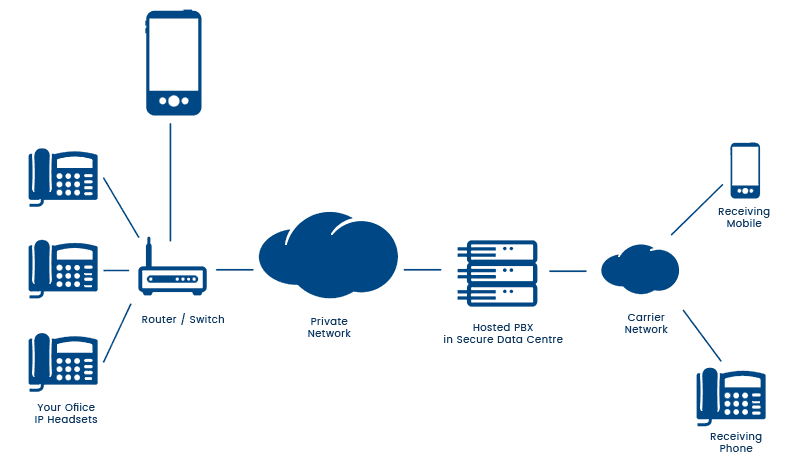How Cloud Phone Systems Are Transforming Business Communications
Unlock the Potential of Your Phone System with SIP Trunks

Are you looking to maximize the potential of your business' phone system? If yes, then you definitely need to consider switching over to SIP trunks. SIP trunks, or Session Initiation Protocol trunks, are virtual telephone lines that allow businesses to make and receive calls without the need for physical phone lines.
Switching over to SIP trunks can save you money in the long run by eliminating costs associated with traditional telephone lines. Moreover, it can also increase your phone system's capacity as well as its flexibility and scalability. That being said, making the switch isn't always easy so it's important to know what you're getting into before you take the plunge.
In this article, we'll take a deep dive into SIP trunks and discuss all that comes with this technology—from its advantages and disadvantages to when and why you should consider making the switch. By the time we're done, you should have all the information needed to decide if SIP trunks are right for your business. Let's get started!
What Are SIP Trunks?
Ready to unlock the potential of your phone system? Say hello to SIP trunks.
SIP (Session Initiation Protocol) trunks are virtual phone lines that allow you to make and receive calls over the internet, bypassing traditional landline networks. They are designed to improve call quality and offer a cost effective solution for high volume phone networks.
SIP trunks provide a variety of features that can help you streamline your day-to-day tasks by cutting back on costs, improving call quality, offering scalability and greater network flexibility, as well as increasing numbers of simultaneous calls. By taking advantage of VoIP technology, you gain access to an extremely reliable service with fewer dropped calls or interrupted connections. Plus you can handle multiple call routing scenarios with ease—all managed via one single platform.
So if you're ready to give your business the competitive edge with communications technology that can grow with your organization and sustain even the most demanding customer demands—it's time to start looking into SIP trunks.
The Benefits of SIP Trunking
If you're looking to reduce costs, increase reliability and scalability, and improve the overall operations of your business phone system, then SIP trunking could be the solution for you.
SIP trunking is a Voice over Internet Protocol (VoIP) service that uses the internet instead of traditional phone lines to provide voice communication services. It is an affordable and flexible service that eliminates costly hardware while allowing businesses to take advantage of advanced features without breaking the bank.
To put it simply, SIP trunking offers many benefits over traditional phone systems. Here are some of its main perks:
- Cost savings: SIP trunking loves you back, and it shows—it requires no additional hardware and can be instantly scaled up or down depending on your needs. This leads to considerable cost savings in terms of installation fees as well as ongoing maintenance.
- High performance: Traditional phone systems can experience latency or slow connection speeds with multiple users connected at once. With SIP trunks, you experience less congestion and better quality calls due to its use of VoIP technology.
- Mobility: By using the internet for connections, phone use can be extended beyond the office space. With SIP trunks, businesses are able to route calls not only through their existing landlines but also through their computers and mobile devices for employees who need mobility or work remotely.
Setting Up Your Phone System With SIP Trunking
Ready to unlock the potential of your phone system and take advantage of SIP trunking? Great! Setting up a SIP trunk is actually easier than you might think. Here's how it works:
- Start by connecting the SIP trunk to your data network. This is going to be the "pipe" that carries the phone calls from your business to the public telephone network and gives you access to features like long distance calling, caller ID, and toll-free numbers.
- Next, you'll set up VoIP gateways for connecting your existing PSTN phone service with the SIP trunks. This allows you to make use of your existing PBX hardware and software while still taking full advantage of SIP trunking technology.
- Finally, you'll need an IP-PBX system, which is a business phone system that works over an IP network (rather than traditional copper wires) and leverages existing computer networks.
Once all of these components are in place, you can begin making use of all the powerful benefits offered by SIP trunking, such as lower call costs, better scalability and reliability ,and more advanced functionality—all enabling your business to be more efficient while saving money on its phone services.
Understanding SIP Trunking and Quality of Service (QoS)
Do you ever find yourself wondering what "SIP Trunking" and "QoS" mean? Well, the acronyms can be intimidating, but the features are actually pretty straightforward.
SIP Trunking
SIP (Session Initiation Protocol) trunking is essentially a voice-over-IP (VoIP) technology that gives businesses access to a cloud-based phone system using their existing internet connection. That means no more jostling with wires or hardware installation; you'll be connected in minutes. It also means you have the scalability to add lines quickly and easily.
Quality of Service (QoS)
QoS guarantees a certain level of call quality on your VoIP system, plus bandwidth prioritization and performance monitoring of your network. With QoS enabled, you'll experience maximum uptime, better reliability and higher call quality—all while all while keeping costs low and improving customer service standards.
Whether it's SIP trunking or QoS, there's no need to worry—unlock the potential of your phone system with these amazing features!
Optimizing Your Network for Maximum Performance With SIP Trunks
When you're looking to maximize your network performance, SIP Trunks can be a great solution. This is because they provide an efficient and cost-effective way of connecting your existing phone system to the internet. With SIP Trunks, you have access to the same features as traditional phone lines such as caller ID, 3-way calling, call transfers and call recording. Plus, with SIP Trunks you can make and receive calls over the internet or mobile networks using Voice Over IP (VoIP).
Here are some of the ways that SIP trunks can help improve your network performance:
- Cost Savings: By utilizing high-speed Internet connections instead of traditional telephone lines, you can save on monthly costs associated with landline rentals and maintenance fees. Additionally, many SIP providers offer discounts for longer term contracts which can further reduce overall expenses.
- Scalability: With SIP Trunking, you'll have the ability to scale up or down quickly and easily based on your business needs. This means that if business picks up or slows down a bit, you won't need to hire additional staff or equipment to accommodate the change in demand.
- Reliability: Traditional PSTN networks are prone to outages due to factors such as weather conditions or human errors. On the other hand, SIP trunks are powered by reliable Internet connections that are usually more resilient than a PSTN network. As a result, uptime is typically higher when using VoIP making it a more reliable option for businesses that require reliable communication services.
Tackling Common Challenges With SIP Trunking
When it comes to your phone system, there are some common challenges that SIP trunking can tackle. For starters, if you're an organization with multiple locations, SIP trunks are ideal for unifying them into one phone system. This way, customers don't have to remember multiple numbers to reach your employees—they can simply call the same number wherever they happen to be located.
Plus, you don't need to purchase multiple hardware systems when you use SIP trunks. This is because all of the hardware is stored offsite in the cloud, eliminating the need for expensive installation fees. That's why businesses of all sizes can invest in more sophisticated phone solutions without breaking the bank.
Other common challenges that SIP trunking can solve include:
- Achieving greater scalability of your phone system – with only a few clicks, you can add more lines as needed
- Opting for more reliable calls – even if your offices are located on opposite sides of the globe, you can be sure that your calls will go through without any hassle
- Protecting from cyber-attacks and other threats – your phone system will be secure thanks to account credentials and encryption algorithms
- Ensuring a high quality of service – since SIP trunks don't use physical media for transmission, voice quality stays consistently high across all channels
When it comes to unlocking the potential of your phone system, SIP Trunking is the way to go. With SIP Trunking, businesses can enjoy enhanced scalability, increased reliability, reduced latency, and improved call quality – without needing to invest in costly hardware upgrades. The cost savings of using SIP trunks are clear, providing businesses with an affordable way to scale their phone systems and take advantage of modern communication solutions.
Whether you’re a small business with basic communication needs or a large enterprise looking for a reliable phone system to keep in touch with your customers, SIP Trunking is an affordable and efficient solution for your business needs. Get the most out of your phone system today and unlock its potential with SIP trunks.











